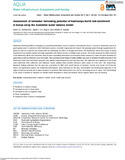Assessment of rainwater harvesting potential of Rachuonyo North Sub-Catchment in Kenya using the Australian water balance model

View/
Date
2022-01-29Author
Odhiambo, Kevin O.
Iro Ong'or, Basil T.
Kanda, Edwin K.
Metadata
Show full item recordAbstract
Rainwater harvesting (RWH) is emerging as a promising alternative source of water in sub-Saharan Africa. It can be an alternative source of good-quality water to substitute other freshwater sources, to enable crop production beyond the growing season through supplemental irrigation as well as to improve the environment by minimizing the effect of drought and floods. The Rachuonyo North Sub-County of Kenya experiences low rainfall coupled with high population with limited access to reliable water sources. The study assessed the RWH potential of the Rachuonyo North Sub-Catchment with the aim of providing information on alternative water resources to meet the water demands for agriculture as well as domestic use in the region. The Australian water balance model (AWBM) was used to simulate the RWH potential of the Rachuonyo North Sub-Catchment using the area rainfall, evapotranspiration and river flow data. The calibration and validation of the model were performed with calibration and validation results yielding Nash–Sutcliffe efficiency (NSE) values of 0.503 and 1.00, respectively. Research findings indicated that the area has a potential for RWH with runoff harvest of between 104,496 and 43,646,142 m3/month, which can significantly support the residential and irrigation water demands for the area. Policymakers and development agencies in the region should pro-actively put in place measures to promote RWH interventions as a tool for increasing access to water. The methodology in the study is suitable for adaption for rainfall–runoff simulation in other sub-Saharan African regions where data are limiting.
URI
https://doi.org/10.2166/aqua.2022.153https://iwaponline.com/aqua/article/71/2/345/86677/Assessment-of-rainwater-harvesting-potential-of
http://ir-library.mmust.ac.ke:8080/xmlui/handle/123456789/2104
Collections
- Gold Collection [1026]
